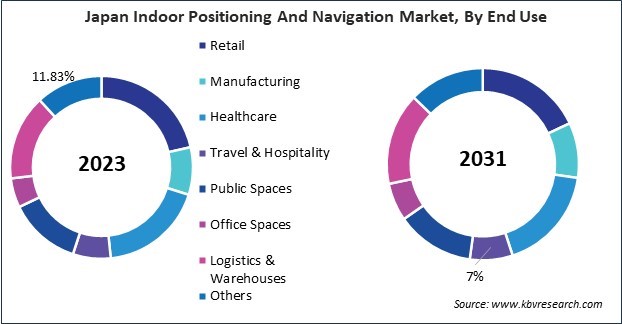The Asia Pacific Indoor Positioning And Navigation Market would witness market growth of 37.9% CAGR during the forecast period (2024-2031).
The China market dominated the Asia Pacific Indoor Positioning And Navigation Market by Country in 2023, and would continue to be a dominant market till 2031; thereby, achieving a market value of $18,596.3 million by 2031. The Japan market is registering a CAGR of 36.8% during (2024 - 2031). Additionally, The India market would showcase a CAGR of 39% during (2024 - 2031).

The healthcare sector is another area where the demand for location-based services surges. Hospitals and healthcare facilities use indoor positioning systems to improve patient care and operational efficiency. These systems enable precise medical equipment tracking, ensuring that critical devices are always available when needed. Additionally, they help navigate patients and visitors through large hospital complexes, reducing stress and improving the overall experience. Real-time location information can also enhance patient safety by monitoring the movement of patients, especially those with cognitive impairments, to prevent wandering and ensure timely assistance.
These systems are also implemented in transportation centers, including airports and train stations, to optimize the travel experience and regulate passenger flow. These systems provide travelers with real-time information about their location, guiding them to gates, baggage claim areas, and other essential facilities. This reduces confusion and delays, leading to a smoother travel experience. Additionally, transportation authorities can use location data to manage crowd control, enhance security, and optimize the utilization of resources.
The Indian logistics industry has been expanding rapidly, driven by the growth of e-commerce and the government's push for infrastructure development. The Indian logistics sector is a critical factor in the acceleration of economic growth and is one of the largest in the globe. Following a 2% contraction in FY21, the market experienced a robust post-COVID recovery in FY22, witnessing a remarkable 14% growth and reaching a value of US$435 billion. The integration of interior positioning systems in warehouses and distribution centers enables improved inventory management, reduces operational costs, and improves the efficiency of supplier chains. Hence, as countries in the Asia Pacific continue to invest in smart technologies and infrastructure development, the demand for these solutions is expected to grow.
Free Valuable Insights: The Global Indoor Positioning And Navigation Market is Predict to reach USD 208.6 Billion by 2031, at a CAGR of 37.2%
Based on Component, the market is segmented into Software, Hardware, and Service. Based on Technology, the market is segmented into Bluetooth Low Energy, Ultra-Wideband Technology, Wi-Fi, and Others. Based on Application, the market is segmented into Asset & Personnel Tracking, Location-Based Analytics, Navigation & Maps, and Others. Based on End Use, the market is segmented into Retail, Manufacturing, Healthcare, Travel & Hospitality, Public Spaces, Office Spaces, Logistics & Warehouses, and Others. Based on countries, the market is segmented into China, Japan, India, South Korea, Singapore, Malaysia, and Rest of Asia Pacific.
By Component
By Technology
By Application
By End Use
By Country
Our team of dedicated experts can provide you with attractive expansion opportunities for your business.

